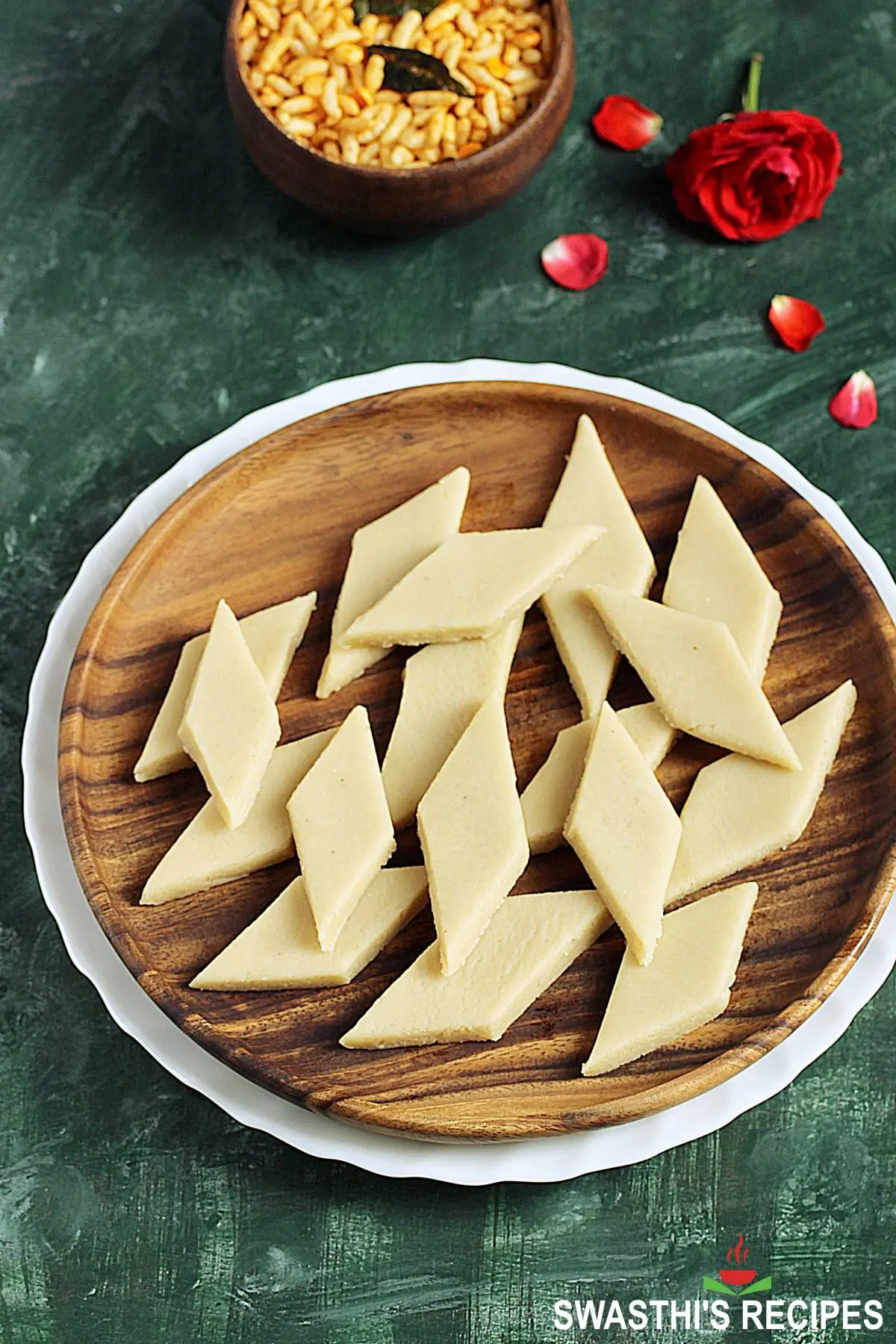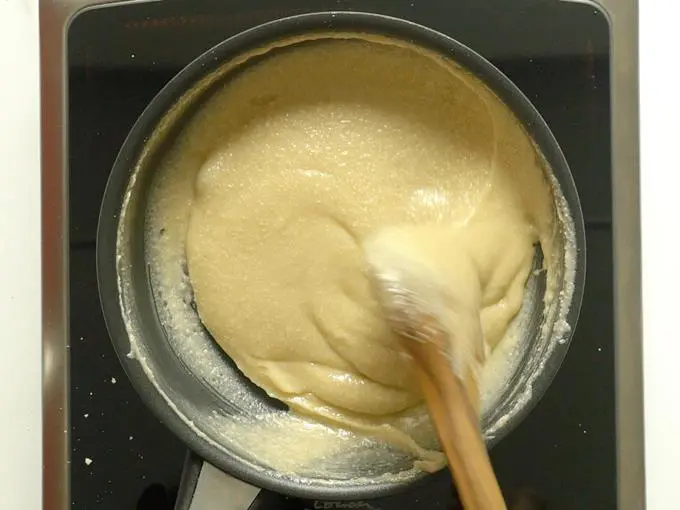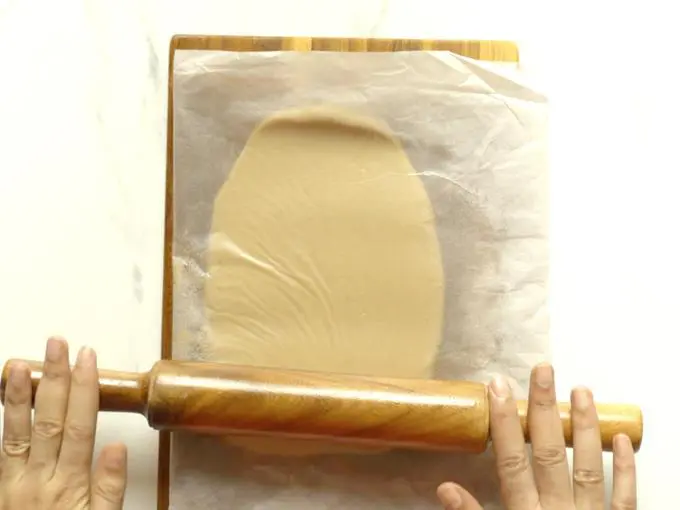Kaju Katli ! Make this super delicious, smooth and perfect Kaju Katli under 30 minutes with just 4 ingredients. Have you ever wondered how the Kaju Katli from the Halwai and Indian mithai stores is so smooth and literally melts in your mouth? In this post I show you how to make the same old fashioned Indian cashew fudge with my easy step-by-step pic guide, video and a bonus – troubleshooting tips.

Also known as Kaju barfi, this requires nothing more than pantry staples – cashews, sugar, a tbsp of ghee and a flavoring ingredient.
It is gluten-free and can be vegan if you use almond or coconut oil in place of ghee.
If you are new to Indian cuisine, read on to know more
About Kaju Katli
Kaju katli is a delicious traditional North Indian sweet made with cashew nuts, sugar and cardamom powder. Here “Kaju” is a Hindi word that translates to “cashews” and katli to “Thin slices”. Kaju katli is rich, exquisite, and amazingly decadent with a smooth melt-in-the-mouth texture. It is mildly flavoured with either cardamom powder, rose water or saffron.
Did you know that kaju katli is among the top selling Indian sweets throughout the year in Indian stores & mithai shops? Yes it is a favourite with all age groups and is loved for its mild flavors, delicious and super addictive texture that literally drives you to a creamy cashew heaven.
Kaju katli is a perfect gift to spread the joy of any special occasion – celebrations & festivals. If you live in India, you will often have your guests gift you a box of kaju katli for Diwali, Navratri or Holi.
While reaching out to a box of kaju katli at your nearest Indian store may be easier but you won’t get the same homemade version that is preservative-free and can possibly be organic if you use organic ingredients.
We rarely buy sweets from the store or halwai shops as most times additives like preservatives and artificial flavouring agents are added to them.
It is easier to make kaju katli at home with my time tested recipe that comes with many latest updated troubleshooting tips and tricks.
Traditional Kaju Katli Vs My Recipe
There are several different ways to make kaju katli. The traditional version is made by getting the sugar syrup to a 1 string consistency to which cashew paste or powder is added. This method is for the cooks who know a bit about the sugar syrup consistency.
But for beginners I have this easiest method which does not require any syrup consistency and does not require a cashew paste. With this method, you will just dissolve the sugar completely and bring the mixture to a rolling boil and then add the cashew powder.
This also gives the best results as good as the traditional method only if you make the cashew powder right and cook the mixture as mentioned in the recipe below.
However if you are an experienced cook, you can still follow this recipe but make a single string consistency first and then add cashew powder to it.
If you are wondering about the difference between these methods – with 1 string consistency you will add more water (½ cup + 2 tbsps water) to make the syrup and cook down until it reaches the desired consistency.
With my method you need to add water just as mentioned in the recipe and not more. If you add too much water for this method you will end up cooking the cashew mixture longer which can alter the color or your kaju katli especially if you are using unrefined sugar /organic sugar.
If you love burfi recipes, then you may love these coconut burfi & 7 cups burfi & Badam burfi.

Pro Tips
Preparing cashew powder
1. Choosing cashews correctly & using them the right way is very important to make a good kaju katli. Here are my tips to choose
Buy unsalted unroasted premium quality cashews. Taste test them first before using in the recipe. Ensure they are bright in color, fresh in taste and flavor. Avoid using cashews that smell or taste stale or rancid and look discoloured.
You can use whole or split cashews. I prefer to split them first to ensure they are good enough & free from bugs/worms & larvae. You may use them whole if you prefer.
2. Texture and temperature of cashews: Make sure your cashews are crunchy and not soft. It is easy to grind crunchy cashews to a fine powder. Soft cashews won’t make a good powder. You won’t get a fine powder with soft cashews. If you grind a lot they release fats faster which we don’t want for this recipe.
Make sure your cashews are at room temperature and not cold. It is very important to use cashews at room temperature. If you store your cashews in the refrigerator like me, then lightly roast them on a low flame for a few minutes until they turn slightly hot to touch. Do not over roast them. We don’t want the kaju katli to discolor. The idea is to use moist free cashews. Cool them completely and then use them to grind.
3. Pulsing or grinding cashews: The texture of your kaju katli depends on how fine your cashew powder is. The finer it is the smoother you get. Use a small grinder jar or a spice jar to powder. Only pulse and blend for short time of about 25 to 30 seconds. Scrape the sides and pulse.
Over blending the cashews or blending for too long will release fats/ oil from cashews. This will not give the right texture to the kaju katli. The mixture will begin to release oil if such powder is cooked.
4. Texture of cashew powder has to be fine but do not aim to make it as fine as flour. It will be slightly grainy or coarse. Make sure cashews are powdered as fine as possible without making the powder lumpy or greasy. Pulse the cashews in intervals and avoid running the grinder for long time.
5. Sieve the cashew powder without fail. This makes the cashew powder light, lump-free and also uniform so you have a kaju katli that is of uniform smooth texture. This step also helps to remove coarse chunks of kaju from the powder. Pulse the coarse chunks again in the grinder. Use a sieve that is not too fine. I use one that can sieve fine semolina.
Cooking the mixture
6. Sugar syrup has to rapidly boil before the cashew powder is added to it otherwise the mixture may turn sticky. Since there is no sugar syrup consistency required for this recipe. This step is very important. The idea is that by the time the syrup comes to a rolling boil, it will be almost around 1 string consistency.
7. Do not overcook the mixture as it dries out the kaju katli. Make sure the cooked mixture has passed the test before transferring it to the parchment paper. If you pour undercooked mixture to the parchment paper, it will become sticky.
8. Knead the mixture well when it is slightly hot and not very hot. This is the key to get smooth and mouth melting kaju katli.
More troubleshooting tips below.
More Sweets Recipes
Diwali Sweets
Besan ladoo
Rasmalai
Gulab jamun
How to Make Kaju Katli (Stepwise Photos)
Grind Cashews
1. Add 200 grams cashews to a blender jar. I had used cashews from fridge. I split open the cashews and then dry roasted on a low flame until crunchy. Cooled completely. I used 1 & 1/2 cups split cashews which weighed 200 grams.

2. Pulse or blend to make a powder. Do not blend at a stretch for long time as they begin to release oil and turn lumpy. I usually blend the cashews in intervals. Also make sure the kaju powder doesn’t turn hot or even warmas it changes the flavor.

3. To make sure the cashew powder is not too coarse I sieved it. You will need to use a spoon to pass it through the sieve.

4. I added back the coarse grains and blended again.

5. The cashew powder will be slightly grainy but not fine like flour. You can also split this kaju katli recipe and make the powder one day ahead. Store it in a air tight jar and use within the next 2 days.

Make Sugar Syrup
6. Add sugar to a non stick pan. I used 3/4 cup + 2 tbsps. The sweetness was right for us. If you prefer less sweetness then you can reduce 2 to 3 tbsp. The organic sugar I use is low in sweetness so 3/4 cup + 2 tbsps is right for us.

7. I poured 6 tbsp water. Pouring too much water is not right for this method as the mixture will have to be cooked for longer. So measure the water correctly.

8. Stir gently and dissolve the sugar completely on a medium heat. Sugar can scratch up the nonstick pan so be gentle. Bring the sugar syrup to a rapid boil.

Cook the Mixture
9. Next lower the flame completely and add cashew powder. I added in 2 batches. You may end up with lumps if the entire powder is added at one time.

10. Next mix very well to ensure there are no lumps. Scrape the sides and the spoon if the powder is stuck.

11. Keep stirring the kaju katli mixture consistently and cook on a low to medium heat until the mixture begins to thicken.

12. Next add 2 tsps ghee and 1 tsp rose water or cardamom powder.

13. Next continue to cook stirring well. As the mixture thickens it will leave the sides if not then add a few drops of ghee again.

14. With in few mins the mixture will come together and leaves the pan. It took about 9 minutes for me to reach this stage. This is just a guideline and may vary depending on the kind of pan and intensity of heat from your stove.

Test the Mixture
When the kaju katli mixture is done, set the pan aside. Take 1/4 tsp of the mixture and cool down a bit. Grease your fingers and make a ball out of it. You must get a non sticky dry soft ball. This means the mixture is ready.
If you do not get a dry ball it means the kaju katli mixture is under done and needs cooking further. Cook for a few more minutes.
15. Next quickly pour the prepared mixture to a greased plate or greased butter paper. If using unbleached parchment paper then grease it first and use.

16. When the temperature comes down to slightly hot, then grease your hands and knead it well.

17. With in 2 to 3 mins the mixture will turn smooth and begin to look slightly dry meaning it is good to set.

18. Next cover the kaju barfi mixture.

19. Roll it to a oval shape of 1/4 inch thickness applying pressure evenly all over.

20. Lastly cool completely and cut to square or diamond shapes. I cut them to the size of Haldiram’s Kaju katli. You can cut them slightly bigger if you like.
How to cut kaju katli? First cut diagonally, spacing 1 ½ inches between each line. Then cut straight, spacing 1 ½ inches between each line. You will get diamond shaped kaju katli.

Most often vark or edible silver foil is placed over the kaju katli. If you prefer you can do it after slicing it.
Store kaju katli in a air tight jar. They keep good at room temperature for 5 to 7 days.

Troubleshooting Tips
Sticky mixture: If your mixture is sticky while you try to knead, it means either the kaju katli mixture is too hot or it is undercooked. Let the mixture cool down slightly but still hot to touch. After this step if you still feel it is sticky it means it is undercooked. Cook it further for a few minutes but don’t overcook.
In the past I would sprinkle little milk powder and fix the sticky mixture. But with so many kinds of milk powders in the market, the results vary and may make the mixture more sticky due to the sugar in the milk powder. So opt for cooking the sticky mixture a little longer.
Dry mixture: If you find your kaju katli mixture to be dry with cracks, then simply splash some warm milk or water and knead it well. With milk the shelf life of your katli will reduce.
Powdery mixture: If your mixture has become powdery it means you either measured your ingredients wrong or you overcooked the mixture. If you have used the right quantities then you may grind the dry mixture in a grinder. Don’t overdo, the mixture may come together on its own if you have not overcooked a lot. Add a splash of water to make it moist and put it back on heat until it comes together. This tip works only if you have not overcooked a lot.
Related Recipes
Recipe Card
Check if mixture is ready
- Water: Please stick on to the quantity of water mentioned in the recipe. If you add even little more water than mentioned in the recipe, you will have to cook the mixture for longer. This may alter the taste of kaju katli making it chewy and the color of the kaju katli alters especially if you are using organic sugar.
- Sugar: I use 3/4 cup plus 2 tbsps sugar (180 grams). You can reduce the quantity by 2 tbsps if you want your katli to be low in sweetness. There are many different kinds of sugar. The Organic sugar I use is low in sweetness so I add 2 tbsps more.
- Using refined white sugar is best for this if you are aiming for a lighter color katli. Alternately you may use edible silver to cover your katli.
- You can also boil the sugar syrup until it reaches 1 string consistency. But you have to use half cup plus 2 tbsps water. Then add the cashew powder. Mix well and add ghee. Cook until the mixture leaves the sides of the pan. When it cools down a bit. Knead it well and follow as mentioned above.
- Before adding the cashew powder, make sure sugar has dissolved completely and has begun to boil well.
Alternative quantities provided in the recipe card are for 1x only, original recipe.
For best results follow my detailed step-by-step photo instructions and tips above the recipe card.
Watch Kaju Katli Video
Nutrition Facts
Kaju Katli Recipe (Kaju Barfi)
Amount Per Serving
Calories 89
Calories from Fat 36
% Daily Value*
Fat 4g6%
Saturated Fat 1g6%
Cholesterol 1mg0%
Sodium 1mg0%
Potassium 63mg2%
Carbohydrates 10g3%
Sugar 8g9%
Protein 1g2%
Vitamin C 0.1mg0%
Calcium 4mg0%
Iron 0.6mg3%
* Percent Daily Values are based on a 2000 calorie diet.
Kaju Katli Recipe first published in September 2012. Updated and republished in 2022 October.
About Swasthi
I’m Swasthi Shreekanth, the recipe developer, food photographer & food writer behind Swasthi’s Recipes. My aim is to help you cook great Indian food with my time-tested recipes. After 2 decades of experience in practical Indian cooking I started this blog to help people cook better & more often at home. Whether you are a novice or an experienced cook I am sure Swasthi’s Recipes will assist you to enhance your cooking skills. More about me
Follow Swasthi’s Recipes





GIPHY App Key not set. Please check settings